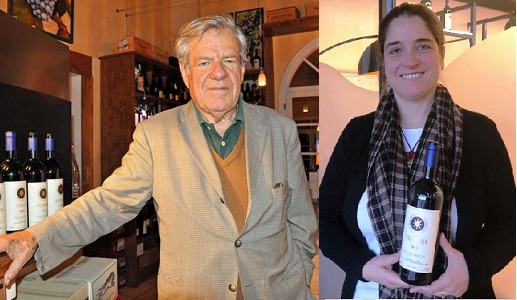The star of Sassicaia

This year marks the 50th anniversary of Sassicaia, the Bolgheri wine that has become a global icon of great Italian red wine.
1968 was not just the year of the French student uprising, of Rudi Dutchke and Daniel Cohn-Bendit. It was also a year that many important events took place in the Italian wine world. An authentic revolution began in Bolgheri, the Tuscan village described by the poet Carducci in his poem “Davanti San Guido” (In front of San Guido) in which he mentioned the road lined on either side by cypress trees leading to it. And on this very road is the Tenuta San Guido estate of the Incisa della Rocchetta Marquises, including the late Mario Incisa della Rochetta.
Wine was already being made there and up until 1948 it was called “della Sassicaia”, indicating it was from the vineyard of the same name located next to the horse training grounds. The Incisa family, in fact, were famous for breeding thoroughbreds including the legendary horses Nearco and Ribot, as well as all the other best horses of that breed. Dormello Olgiata trained on those grounds next to the vineyards and Mario Incisa even hired Federico Tesio, the greatest thoroughbred trainer in the history world horseracing, to work for him.
While all this has little to do with wine, it does reflect Mario Incisa’s as of thinking, I’d say natural philosophy, and wine has to do with his family connection with the Antinori family. It was Niccolò Antinori and his son Piero, in fact, who suggested he turn to Giacomo Tachis for help in expanding the production of this Bolgheri wine. At the time the area was certainly not famous for producing great wine but his were made with Cabernet Sauvignon, the vines for which Incisa acquired from Duke Salviati di Migliarino.
Under Tachis’ supervision, Sassicaia made its debut with vintage 1968, even if it was later learned that it was a blend of the 1966, 1967 and 1968 vintages and perhaps even a bit of 1965 and 1969. Then again, the student revolt in France was inspired by the one in Berkley before and Marcuse was also an idol in Nanterre. It should also be noted that the first vintage reached the market in 1971, two years after harvest.
Sassicaia was a wine completely different than what had been produced in Italy before it. Beginning with vintage 1972, it was made using French barriques, 225-liter casks made of Massif Central oak that previously had only been experimented with by Nelo Letrari, who at the time was the enologist for Bossi Fedrigotti, to produce Foianeghe Rosso near Rovereto back in 1962.
Back then, Bolgheri was known for its beaches, pine forests and horses while the wine was considered mediocre (only the rosé had a DOC classification). Sassicaia was not made with Sangiovese, the Tuscan red wine grape par excellence, but with the very French Cabernet Sauvignon together with a small addition of Cabernet Franc. It was also the product of a concept rather than tradition and this was truly revolutionary for the sleepy and conservative world of winemaking.
Being a man of unusual intelligence and taste, Gino Veronelli immediately recognized its value and began writing about it. By the middle of the 1970s, Sassicaia di Bolgheri, a red wine without a DOC classification and with no history behind it, was already a legend in the world of Italian winemaking. And it lit a fuse that would ignite a peaceful revolution in winemaking, first in Tuscany and later in the rest of Italy. I would even go so far to say that all modern Italian wines are its descendants.
Which are the best vintages? Don’t tell anyone but I prefer the 1988 to the 1985, the vintage that consolidated its legend. Then there are the 1998 and 2001, while among the older vintages I’d say the 1977 and 1978. The better more modern vintages are 2009 and the “magical trio” 2011, 2012 and 2013 along with the very great 2015. Mario Incisa died almost 30 years ago and since then the estate has been run by his son Niccolò, a reserved and kind man who has worked in the shadows to offer wine lovers authentic and unmatchable gems. For some years now the winery’s continuity has been ensured by Priscilla Incisa della Rocchetta, Nicolò’s daughter and Mario’s granddaughter.
Today Sassicaia, which in 1994 was classified as DOC Bolgheri Sassicaia, is perhaps the most famous Italian wine for critics and wine lovers the world over and is often compared to the great premier crus of Bordeaux.
Then again, when he was very young in the 1920s, Mario Incisa tasted a red wine made by the Duke Salviati di Migliarino from Cabernet Sauvignon and wrote how it reminded him of an old Bordeaux he had tasted some time beforehand.
Sassicaia, or better Bolgheri Sassicaia, is made today with a selection of grapes from some 90 hectares of vineyards and while there is no official data on production, it is probably less than 200,000 bottles a year, half that of most of the Bordeaux Premier cru. The price for the latest vintage available, 2015, is around 200 euros in a wine shop while the rare and prestigious vintages, like the legendary 1985, can sell for over 2,000 euros at international wines auctions.
Tomorrow we will examine the organoleptic characteristics of 50 years of this legendary wine.

 Italiano
Italiano








